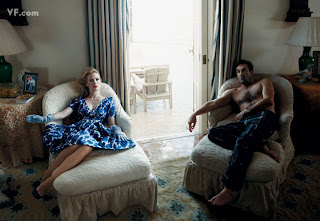 I first stumbled on Mad Men channel surfing through On Demand one idle evening, watched the first episode, and was hooked by its sexiness and considerable style. I was pleased to see that the series featured January Jones—whose performance as a disillusioned young bride in The Three Burials of Melquiades Estrada moved me to melancholy—and it was sweet to see her once again distractedly smoking cigarettes to stave off ennui. Though I couldn't quite place him at first, it was equally intriguing to watch Vincent Kartheiser as the obsequious Pete Campbell; a far cry from his heartfelt performance in Larry Clark's Another Day In Paradise. But, of course, it was Jon Hamm as Don Draper who captivated my attention for being bracingly handsome; the kind of man American culture let get away; and the kind of man Mad Men has winningly resurrected with full intent to deconstruct.
I first stumbled on Mad Men channel surfing through On Demand one idle evening, watched the first episode, and was hooked by its sexiness and considerable style. I was pleased to see that the series featured January Jones—whose performance as a disillusioned young bride in The Three Burials of Melquiades Estrada moved me to melancholy—and it was sweet to see her once again distractedly smoking cigarettes to stave off ennui. Though I couldn't quite place him at first, it was equally intriguing to watch Vincent Kartheiser as the obsequious Pete Campbell; a far cry from his heartfelt performance in Larry Clark's Another Day In Paradise. But, of course, it was Jon Hamm as Don Draper who captivated my attention for being bracingly handsome; the kind of man American culture let get away; and the kind of man Mad Men has winningly resurrected with full intent to deconstruct. With Season Three ready to launch Sunday, August 16 on AMC, Vanity Fair's deputy editor Bruce Handy has written a fantastic three-part essay on Mad Men for the September 2009 issue, available at VF's online site. The feature article profiles Mad Men's creator (and former Sopranos writer) Matthew Weiner, the casting of Jon Hamm and January Jones as Don and Betty Draper, and the obsession that fuels each episode. Handy supplements this article with an interview with John Slattery—who plays "the droll and sybaritic" Roger Sterling—and an interview (and slideshow!) with costume designer Janie Bryant. Vanity Fair likewise offers a short video of Handy extolling the virtues of the series during Annie Leibovitz's photo shoot of the cast. Leibovitz's evocative gallery is likewise on line.
With Season Three ready to launch Sunday, August 16 on AMC, Vanity Fair's deputy editor Bruce Handy has written a fantastic three-part essay on Mad Men for the September 2009 issue, available at VF's online site. The feature article profiles Mad Men's creator (and former Sopranos writer) Matthew Weiner, the casting of Jon Hamm and January Jones as Don and Betty Draper, and the obsession that fuels each episode. Handy supplements this article with an interview with John Slattery—who plays "the droll and sybaritic" Roger Sterling—and an interview (and slideshow!) with costume designer Janie Bryant. Vanity Fair likewise offers a short video of Handy extolling the virtues of the series during Annie Leibovitz's photo shoot of the cast. Leibovitz's evocative gallery is likewise on line. Handy describes Mad Men's stylized title sequence: "which depicts Don Draper standing in a dissolving office and then plummeting into a glass-and-steel Manhattan canyon, taunted by glimpses of the good life as seen in old magazine ads."
Handy describes Mad Men's stylized title sequence: "which depicts Don Draper standing in a dissolving office and then plummeting into a glass-and-steel Manhattan canyon, taunted by glimpses of the good life as seen in old magazine ads."Handy adds: "But while the show, like its subject, has many surface pleasures—period design, period bad behavior (if you like high modernism, narrow lapels, bullet bras, smoking, heavy drinking at lunch, good hotel sex, and bad office sex, this is the series for you)—at its core Mad Men is a moving and sometimes profound meditation on the deceptive allure of surface, and on the deeper mysteries of identity. The dialogue is almost invariably witty, but the silences, of which there are many, speak loudest."
 Eventually he summarizes: "Mad Men is too clear-eyed about its period to be called nostalgic—Weiner loves writing anti-Semitic wisecracks for his admen and showing pregnant women with cigarettes dangling from their lips—but at the same time there can be a yearning tug, even an ache, in the intensity of the show's backward gaze. Maybe it's a kind of wised-up, at times even loathing nostalgia—precisely the kind of contradiction that drives the show creatively."
Eventually he summarizes: "Mad Men is too clear-eyed about its period to be called nostalgic—Weiner loves writing anti-Semitic wisecracks for his admen and showing pregnant women with cigarettes dangling from their lips—but at the same time there can be a yearning tug, even an ache, in the intensity of the show's backward gaze. Maybe it's a kind of wised-up, at times even loathing nostalgia—precisely the kind of contradiction that drives the show creatively."Photos courtesy of Annie Leibovitz, Vanity Fair. Cross-published on Twitch.